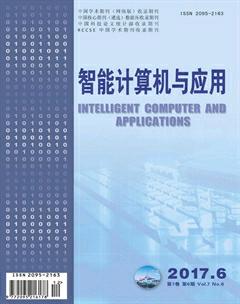基于5×5邻域内的LGC人脸表情识别
沈思+司思思
摘要: 应用于面部表情识别的算法中,传统的局部二进制模式(LBP)算法能够分析出中心像素与相邻像素之间的灰度关系,但是忽略了额头、眼睛、嘴巴以及其他一些区域在梯度方向上的表情分布趋势。因此,提出了基于5×5邻域内局部梯度方向(LGC-FN)的特征提取方法,通过对5×5邻域内横向和对角线方向上的二进制编码得到融合的特征,可以准确地描述由于皱纹、面部肌肉等形变产生的表情信息。最后,使用支持向量机(SVM)进行特征分类。通过实验证明了提出的方法可以有效地提高面部表情的识别率。
关键词: 中图分类号: 文献标志码: A文章编号: 2095-2163(2017)06-0047-03
Abstract: The traditional Local Binary Pattern (LBP) algorithm can analyze the gray relationship between the center pixel and neighboring pixels, using in facial expression recognition, but neglect the expression feature different trends of the eys, mouth, forehead and other areas in the gradient direction. Therefore, this paper proposes a method of local gradient direction in the 5×5 neighborhood(LGC-FN), through the binary encoding to the horizontal, vertical gradients respectively, to produce the fusion characteristic, then this can fully describe the experssion information contained in the wrinkles, facial muscles texture, and other local deformation. Finally, the paper applies the Support Vector Machine(SVM) to classify the extracted. The experimental results show that the proposed method can effectively improve the recognition rate of facial expression.
0引言
人與机器之间的高级智能交互是研究表情识别的重要目标之一[1]。表情特征提取是面部表情识别系统中的关键[2]。局部特征方法对姿态变化、遮挡以及光照等因素的影响具有较强鲁棒性,其中局部二进制模式[3]和Gabor[4]小波变换是最具有代表性的两种方法[5]。Gabor小波变换能够检测出多尺度、多方向纹理的变化,但特征尺度巨大并且耗时长。
LBP(Local Binary Pattern)算法却可快速提取面部表情特征,具有强大的纹理识别能力,并在模式识别领域也得到了越来越多的认可[6]。但传统的LBP算法不能准确地描述面部肌肉、皱纹以及其他局部形变的纹理信息。2014年,Tong等人提出了LGC方法,但仍然会使一部分梯度方向上的特征无法得到区分[7]。
针对上述问题,提出了一种基于5×5邻域内的LGC (LGC-FN)特征提取方法,实验表明,与传统的局部二进制模式算法、LGC-HD算法[7]、Gabor小波变换相比,本文提出的方法可以使表情识别率得到提高。
1LGC算子
4结束语
实验结果表明,本文提出的方法能够更加准确地描述由于面部肌肉形变所产生的梯度方向上的表情信息,提高表情识别率,但是由于没有结合使用降维方法,获得的特征向量维度偏高,使得时间消耗稍大,为了进一步优化该方法,后续研究需要结合一些降维方法以降低向量维度,提高识别效率,减少时间消耗。
参考文献:
[1] FASEL B, LUETTIN J. Automatic facial expression analysis: A survey[J]. Pattern Recognition, 2003,36 (1): 259-275.
[2] SHAN Caifeng, GONG Shaogang, MCOWAN P W. Facial expression recognition based on local binary patterns: A comprehensive study[J]. Image and Vision Computing, 2009,27 (6): 803-816.
[3] OJALA T, PIETIKAINEN M, HARWOOD D. A comparative study of texture measures with classification based on feature distributions[J]. Pattern Recognition, 1996, 29 (1):51-59.
[4] DAUGMAN J G. Uncertainty relation for resolution in space, spatial frequency,and orientation optimized by two-dimensional visual cortical filters[J]. J. Opt. Soc.Am. A,1985, 2 (7):1160-1169.
[5] AHONEN T, HADID A, PIETIKAINEN M. Face description with local binary patterns: Application to face recognition[J]. IEEE Transactions on Pattern Analysis and Machine Intelligence, 2006, 28 (12):2037–2041.
[6] WANG Wei, HUANG Feifei, LI Jianwei, et al. Face description and recognition by LBP pyramid[J]. Journal of Computer-Aided Design & Computer Graphics, 2009, 21 (1): 94-100, 106.
[7] TONG Ying, CHEN Rui, CHENG Yong. Facial expression recognition algorithm using LGC based on horizontal and diagonal prior principle[J]. OptikInternational Journal for Light and Electron Optics,2014,125(16):4186-4189.
[8] KANADE T, TIAN Yingli, COHN J F. Comprehensive database for facial expression analysis[C]//Fourth IEEE International Conference on Automatic Face and Gesture Recognition. Washington, DC, USA:IEEE, 2000:46-53.
[9] ROSENFELD A, KAK A C. Digital image processing[M]. 2nd Ed. New York:Academic Press, 1982.endprint

